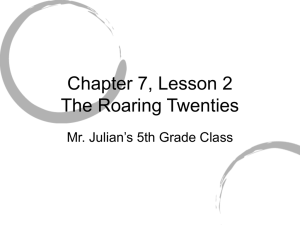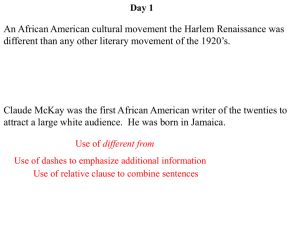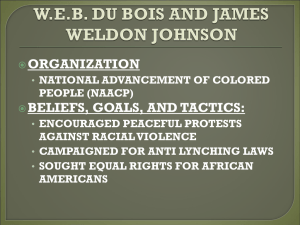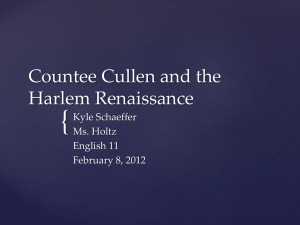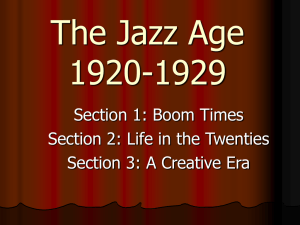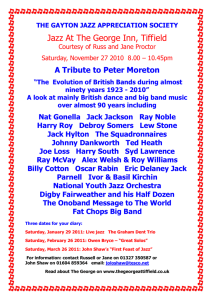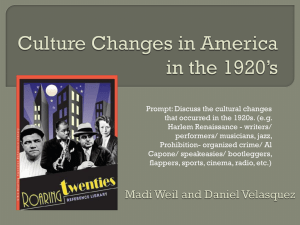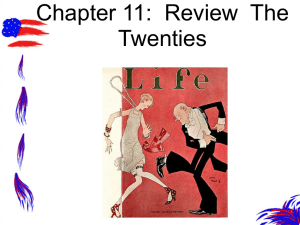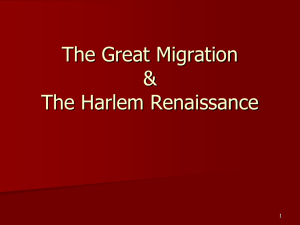The roaring 20`s
advertisement
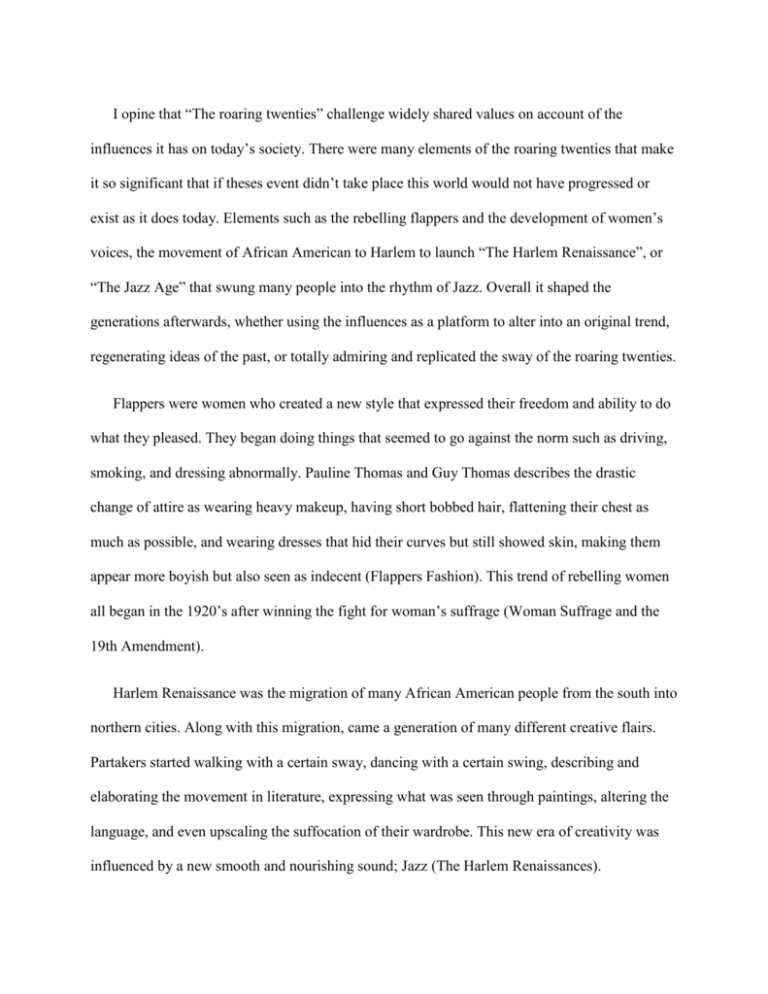
I opine that “The roaring twenties” challenge widely shared values on account of the influences it has on today’s society. There were many elements of the roaring twenties that make it so significant that if theses event didn’t take place this world would not have progressed or exist as it does today. Elements such as the rebelling flappers and the development of women’s voices, the movement of African American to Harlem to launch “The Harlem Renaissance”, or “The Jazz Age” that swung many people into the rhythm of Jazz. Overall it shaped the generations afterwards, whether using the influences as a platform to alter into an original trend, regenerating ideas of the past, or totally admiring and replicated the sway of the roaring twenties. Flappers were women who created a new style that expressed their freedom and ability to do what they pleased. They began doing things that seemed to go against the norm such as driving, smoking, and dressing abnormally. Pauline Thomas and Guy Thomas describes the drastic change of attire as wearing heavy makeup, having short bobbed hair, flattening their chest as much as possible, and wearing dresses that hid their curves but still showed skin, making them appear more boyish but also seen as indecent (Flappers Fashion). This trend of rebelling women all began in the 1920’s after winning the fight for woman’s suffrage (Woman Suffrage and the 19th Amendment). Harlem Renaissance was the migration of many African American people from the south into northern cities. Along with this migration, came a generation of many different creative flairs. Partakers started walking with a certain sway, dancing with a certain swing, describing and elaborating the movement in literature, expressing what was seen through paintings, altering the language, and even upscaling the suffocation of their wardrobe. This new era of creativity was influenced by a new smooth and nourishing sound; Jazz (The Harlem Renaissances). The outburst of the Jazz Age was from the rhythmic movement from the south overfilled northern cities, such as Detroit, Chicago, and most significant Harlem, with the beautiful melody of Jazz. Jazz was a sound that lost color and was enjoyed by almost everyone whether white or black. It made people bind together whether sharing the newest swings, singing the newest song, or showcasing the latest dressing styles. Jazz was a sound that everyone could relate too, therefore presenting a side of the community that no one had ever experienced before (the Jazz Age). The generation of Flappers was the first generation of women to have women’s rights being obliged. Therefore I believe this is the generation of which women started making a voice for themselves. From personal experiences I witnessed my Great Grandmother, who was born 1913, exhibit traits of a strong woman mounting them into me as well as the rest of my family. After hearing stories of how women poured blood, sweat, and tears into gaining rights, I knew her generation was the turning point of earning women’s right. A strong backbone, tough skin, and an opinionated voice were traits developed in the 1920’s and especially presented in Flappers. These traits are also the traits definitely instilled in women of today generation. Harlem Renaissance was an opportunity for African American to display talents, take advantage of many unskilled industrial opportunities, gain an education, and escape the harsh racism of the south. This sudden movement filled cities and cultivated businesses. They now had plenty of youthful hard workers willing to do anything to earn a living. The main importance of the Harlem Renaissance is the stimulation of creativity it struck. It introduced musicians such as the late and great Duke Ellington and Louis Armstrong or singers such as Ella Fitzgerald and Miss Billie Holiday. It was accentuated in writings such as “Democracy” by Langston Hughes and The Blacker the Berry by Wallace Thurman (Writers and Poets of the Harlem Renaissance) or captured on a canvas in Dreams by Jacob Lawrence and Study for God’s Trombone by Aaron Douglas (Artists of Harlem Renaissances). Basically, the Harlem Renaissance is what molded the African American culture of what it is today. Though Jazz was discovered mostly down south by African American it was adopted by many cultures soon after African American settled into urban cities. It was a way for people of the north to have a common interest, and put aside their differences. Most people loved the new sound, practiced the new swings, and hummed the trendy songs. It was a new way of life as it seemed, and to be “It” you had to follow; which led to the interaction of every culture. Many African American talents influenced the white people to adopt and enhance Jazz. There were musicians such as Bix Beiderbecke (Chicago: White Jazz) and Richard M. Sudhalter (Richard M. Sudhalter, 69, jazz trumpeter and author) who mastered the sound of Jazz, spreading it throughout their own culture. This Jazz Mixture was only beginning of music, literature, and arts bringing people together. In conclusion, the roaring twenties has definitely challenged widely shared values due to the huge change that still has influences on us today. An example would have to be the beginning of women standing up for themselves and exploring what they want. Their objection is the reason why we have had Hillary Clinton run for Presidency and why Oprah is known as the most powerful person in the World. They have opened doors giving us opportunities for women in the past, present, and even the far future. Another example would be the effects of Harlem Renaissance. It opened the door to the creativity and hardworking culture of African American; a door that still influences us today to be original in all forms of literature, art, and music. Lastly the Jazz Age, brought people together by the powerful yet soothing sound of Jazz. Jazz brought people together, regardless of race, to share trends starting from the latest songs to the newest oxford shoes. Ultimately, the roaring twenties absolutely had an impact on society back then and certainly today. Work citation Martin, Douglas. "Richard M. Sudhalter, 69, Jazz Trumpeter and Author." Boston.com. The New York Times, 21 Sept. 2008. Web. 28 Aug. 2014 Pbs.org. "The Harlem Renaissance." PBS. PBS, 2002. Web. 27 Aug. 2014. "People & Events: The Jazz Age." PBS. PBS, 1999-2001. Web. 28 Aug. 2014. Phylicia and Sari. "Artists." The Harlem Renaissance. Weebly, 2011. Web. 27 Aug. 2014. Phylicia and Sari. "Writers and Poets." The Harlem Renaissance. Weebly, 2011. Web. 27 Aug. Scaruffi, Piero. "A History of Jazz Music." A History of Jazz Music. Piero Scaruffi, 2005. Web. 27 Aug. 2014. "The Jazz Age". HistoryLearningSite.co.uk. 2005. Web. 27 Aug.2014 Thomas, Pauline, and Guy Thomas. "Flapper Fashion 1920sC20th Fashion History." 1920s Flapper Fashion History. C20th Costume History for Women in the 1920's. Pauline Thomas, 2001-2014. Web. 26 Aug. 2014. Ushistory.org. "The Harlem Renaissance." Ushistory.org. Independence Hall Association, 2014. Web. 26 Aug. 2014. "Woman Suffrage and the 19th Amendment." National Archives and Records Administration. National Archives and Records Administration, n.d. Web. 28 Aug. 2014.
